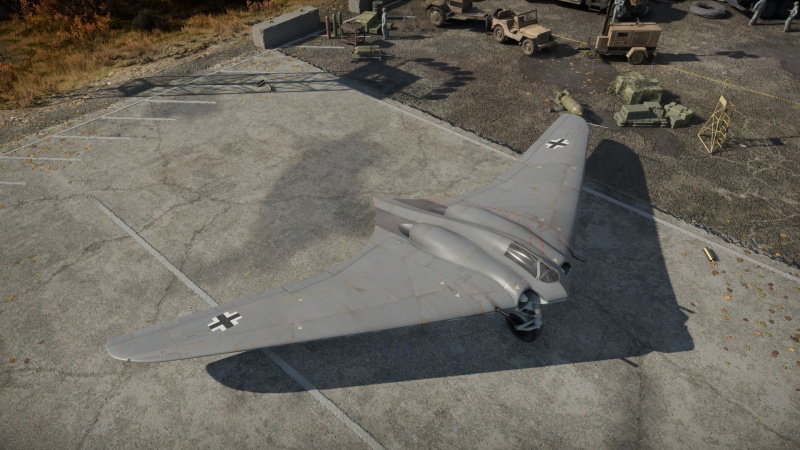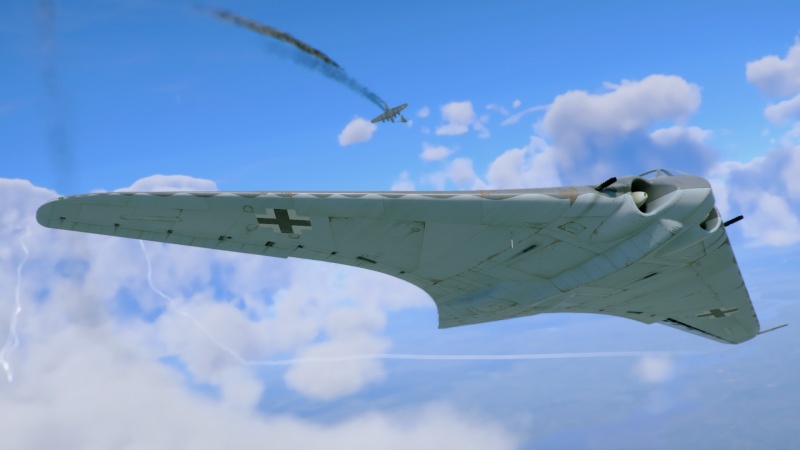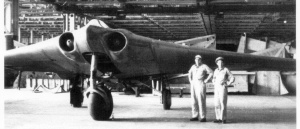Ho 229 V3
Contents
Description
The Horten Ho 229, also known by its production designation as the Gotha Go 229, is a jet-powered flying wing aircraft designed by the Horten brothers in Germany during the later stages of World War II. It was originally designed in 1943 in response to the RLM's requirements for a "3×1000" fast bomber; an aircraft capable of carrying up to 1,000 kg of bombs, with a range of 1,000 km, and a speed up to 1,000 km/h. Development of the Ho 229 was later reassigned to the Emergency Fighter Program in 1944, which aimed to produce cheap and simple fighters that could defend the Reich from Allied bombers. To reduce costs, Gothaer simplified the design, most notably redesigning the wings to be made of a mixture of plywood panels glued with charcoal and sawdust mixture and attached it to a steel "fuselage" mid-section. The Ho 229 V3 was the third prototype of the Ho 229, and was intended to be the testbed for the first production model, capable of carrying two 30 mm cannons and, later on, possibly a 1,000 kg bomb load. The Ho 229 V3 was never completed, as it was captured by US forces in April 1945 at the Gothaer Waggonfabrik factory. The Ho 229 V3 was the only surviving example of the Ho 229, and it is currently on display at the Smithsonian National Air and Space Museum in Washington, D.C.
The Ho 229 V3 was introduced in Update 1.43. It is the first jet in the "Zerstörer" tech tree of the Luftwaffe and currently comes before the G.91 R/3. Ironically, it goes against much of the doctrine set by the previous planes, favouring speed and manoeuvrability over armament and durability. Something that will immediately stand out with the Ho 229 V3 is how incredibly manoeuvrable it is compared to most other jet fighters. The Ho 229 V3 can almost quite literally turn on a dime and can even in some circumstances out-turn late super props such as the P-51H if manoeuvred correctly. However, if its manoeuvrability is used to its full extent, it also causes the plane to bleed speed at a crippling rate, making a sustained turn fight impossible to win. As such, it is advised to use the Ho 229 V3 as a Boom & Zoom fighter in order to maintain airspeed and altitude. Remember that jet engines' efficiency is directly proportional to the IAS, due to the increased air intake, meaning the Ho 229 V3 will be accelerating very slowly between 0-500 km/h, but beyond will be able to outrun any propeller-driven aircraft.
General info
Flight performance
The Ho 229 V3 is a very unique aircraft in many senses. It was designed as a "pure" flying wing design with a notable absence of the tail section and a "fuselage" merged into the wing in one piece, aiming to reduce the drag as much as possible while maximizing the lifting and aerodynamic capability. This results in the Horten having very low wing loading, generating more than enough lift to keep the plane in the air, and having very low stall speed (especially for a jet aircraft) at 165 km/h, giving the Horten the ability to execute the unconventional "cobra" manoeuvres by baiting the opponent into chasing it vertically until they ran out of air speed and stall, then you can swiftly roll down from the ascent to finish them off.
The lack of drag allows the Horten to have very tight turn radius, especially at medium speeds (around 400-600 km), though this is often offset by the excessive lift that hampers the pitch and roll rate at times. The flying wing design also means that the plane can retains the energy very well while flying straight, but bleeds the energy very quickly in an aggressive turn or prolonged horizontal manoeuvres.
While the Ho 229 V3 shares the common deficiency of early jets of slow initial acceleration, the Horten can gain energy relatively quickly by taking a shallow dive. While the initial gain is relatively slow, the plane will eventually accelerate enough to gain momentum for climbing. The plane's excellent lift will allow it to climb much more efficiently than other early jets with noticeably less energy loss. Though, be sure to avoid prolonged dogfights as the plane still requires a significant amount of time to regain its energy.
A caveat worth noting about the Horten is its tendency to bounce while landing, especially at a speed above 200 km/h, which often results in the plane overshooting the runway. As such, be sure to use the plane's airbrake to bleed the energy when beginning an approach, then keep the throttle on to maintain the airspeed between 160 - 200 km/h and reduce the chance of abrupt stall as you proceed to land on the runway, then apply the brakes when all wheels have touched the ground.
| Characteristics | Max Speed (km/h at 8,000 m) |
Max altitude (metres) |
Turn time (seconds) |
Rate of climb (metres/second) |
Take-off run (metres) | |||
|---|---|---|---|---|---|---|---|---|
| AB | RB | AB | RB | AB | RB | |||
| Stock | 871 | 847 | 24.8 | 25.4 | 17.0 | 16.1 | 850 | |
| Upgraded | 950 | 910 | 23.4 | 24.0 | 25.5 | 21.0 | ||
Details
| Features | |||||
|---|---|---|---|---|---|
| Combat flaps | Take-off flaps | Landing flaps | Air brakes | Arrestor gear | Drogue chute |
| ✓ | ✓ | ✓ | ✓ | X | X |
| Limits | ||||||
|---|---|---|---|---|---|---|
| Wings (km/h) | Gear (km/h) | Flaps (km/h) | Max Static G | |||
| Combat | Take-off | Landing | + | - | ||
| 980 | 558 | 529 | 380 | ~10 | ~5 | |
| Optimal velocities (km/h) | |||
|---|---|---|---|
| Ailerons | Rudder | Elevators | Radiator |
| < 570 | < 600 | < 420 | N/A |
Engine performance
| Engine | Aircraft mass | |||||||
|---|---|---|---|---|---|---|---|---|
| Engine name | Number | Empty mass | Wing loading (full fuel) | |||||
| Junkers Jumo 004D | 2 | 4,800 kg | 188 kg/m2 | |||||
| Engine characteristics | Mass with fuel (no weapons load) | Max Takeoff Weight | ||||||
| Weight (each) | Type | 17m fuel | 20m fuel | 30m fuel | 45m fuel | 57m fuel | ||
| 750 kg | Axial-flow turbojet | 5,541 kg | 5,667 kg | 6,088 kg | 6,720 kg | 7,255 kg | 7,500 kg | |
| Maximum engine thrust @ 0 m (RB / SB) | Thrust to weight ratio @ 0 m (100%) | |||||||
| Condition | 100% | WEP | 17m fuel | 20m fuel | 30m fuel | 45m fuel | 57m fuel | MTOW |
| Stationary | 1,050 kgf | N/A | 0.38 | 0.37 | 0.34 | 0.31 | 0.29 | 0.28 |
| Optimal | 1,050 kgf (0 km/h) |
N/A | 0.38 | 0.37 | 0.34 | 0.31 | 0.29 | 0.28 |
Survivability and armour
An obvious flaw of the Ho 229 is the large surface area created by the flying wing design. This means that is it easier for enemies to land a shot on the plane. It can be countered by turning the side of your plane towards the enemy, henceforth decreasing the surface area that can be shot.
Modifications and economy
Given the Horten's weight, the acceleration is an issue on the stock plane. Go for ammunition, engine and compressor upgrades first.
After that, any upgrade is equally good. Weapon upgrades can wait, as the Mk 103 is the best gun in-game, with high accuracy and long bursts stock. The belts also shouldn't be a priority unless using the Ho 229 as an attacker. In that case, the "Armoured targets" belt is very useful against tanks & light pillboxes.
Armaments
Offensive armament
The Ho 229 V3 is armed with:
- 2 x 30 mm MK 103 cannons, wing-mounted (170 rpg = 340 total)
Ammunition
- Default: HEI-T · IT · AP-I; okay against planes.
- Armoured targets: HVAP-T · IT · HVAP-T · AP-I; the armoured target belt is different for the Ho 229 V3, compared to all other Mk 103 armed aircraft, and is only a 1/2 as effective, due to the belt being filled with incendiary shells.
- Air targets: HEI-T · HEI-T · HEI-T · IT; each Minengeschoß (mine-shell) has the same HE power as a 37 mm round, wonderful against anything that flies and light ground targets.
- Stealth: AP-I; difficult to use; cannot destroy most tanks nor pillboxes, lacks the destructive force of HE shells against planes.
Usage in battles
The Horten 229 flying wing is a dogfighter, heavy-fighter, or even an attacker.
Its single wing design allows for amazing manoeuvrability despite its weight of up to 8 tonnes, when equipped with full fuel load. This is, however, the Horten's literal downfall; the weight. Its acceleration is awful, even for jets. But the energy retention is great and climb acceptable. With that in mind rule number one of jet battle comes into play: do not turnfight! The 229 will tempt anyone though. The low wing loading for a jet and even some piston planes allows for tight turning circles. Being heavy also allows to keep that velocity well in the initial turns, but with the inability to regain that speed afterwards... leads to a flaming wreck thanks to an opportunistic enemy. The classic dogfight is thus only for emergency situations!
As a fighter, stick with Boom & Zoom, in which the Ho 229's heavy weight is of assistance in zoom climbs. However, it will also dampen the Horten's starting acceleration in a dive, making out diving an enemy difficult. The bad roll rate makes it hard to get some shots on target, But watch out! Don't pull too hard on the elevator to get that shot, or the Horten will lose much speed (which cannot be regained quickly) or rarely, lose a wing.
The heavy fighter role equals the fighter one in every aspect, just that the targets are usually bombers. Stay fast, and try to get shots off in head-ons, or in slight diving turns from the bomber's six (tail), to make it difficult for the defensive gunners to hit the Ho 229.
The attacker role is a dangerous one. The Ho 229 will have to fly slow, in order to have time to properly aim, hit & evade trees. While all of these aren't difficult in the Horten 229 V3, it leaves the plane in a dangerous spot: low and without speed. Both are vital though for the sluggish plane. In this role, be sure to have good escort fighters, as enemies can come at any time in jet combat.
Once the Horten is fully upgraded, or at least the performance parts are, one detail to notice is that the wings won't rip so easily like before, but the Ho 229 still has to turn cautiously, because it is still a wooden plane after all.
Perhaps the most dangerous enemy of the Horten 229 is the F-84 Thunderjet. Since the Thunderjet gets an air spawn it already has all the energy it needs to get around the map quickly. There are occasions when players spawn in late, only to be strafed by an F-84 Thunderjet on the runway. The Ho 229 is decent at accelerating once up to about 550 km/h, past that point, the Ho 229 becomes a V2 rocket in terms of acceleration until about ~750-800 km/h, then there will be a hard time accelerating again.
Pros and cons
Pros:
- Excellent 30 mm autocannon with access to a 3/4 minengeschoß tracer belt and good ammo count
- Low wing loading, incredibly good at turning when flown at medium speeds (400-600 km/h)
- Good energy retention if not manoeuvred too harshly
- Outruns piston-engine aircraft and all Allied jets, except when up-tiered
- Very low stall speed of 165 km/h, capable of baiting opponents into stalling and strike back
- Fast when diving if flown at medium to high speeds before committing to a dive
- The air brake can bleed airspeed efficiently
- Excellent cockpit visibility in SB
Cons:
- Slow rate of fire results in occasional misses when sweeping quickly behind enemies if aiming at wings, which have a thin profile
- Only half of its armoured target belt is comprised of HVAP-T shells, unlike other MK 103 equipped aircraft, which have only HVAP-T shells
- Acceleration is slow, even its initial acceleration in a dive
- Is easy to hit when turning, above, or below because of the size
- Wings can be easily overloaded while turning at high speed
- Flying wing design results into poor roll rate and yaw speed, and causing the plane to loses speed quickly in elevator turns
- Difficult to land due to its tendency to bounce on contact with the runway
- Gets matched against enemy jets that have superior performance
History
In the 1930s, the Horten Brothers were really interested by the concept of "flying wing" for the potential of drag reduction.
In 1943, Marshal Hermann Göring requested a plane that could carry a 1,000 kg bomb load to a range of 1,000 km at a speed of 1,000 km/h. Because jet engines of the time had poor efficiency, the Horten Brothers thought putting them in a flying wing, which had reduced drag, was the solution.
The Horten Brothers proposed their project for a bomber, Ho IX, but the Reichsluftfahrtministerium (RLM) thought the plane would be better as a jet fighter than a long range bomber and requested that two MK 103 cannons were mounted. The result was the prototype Ho 229.
The Ho 229 was the culmination of over 14 years of research and experiment by the Horten brothers for a flying wing design, which aims to maximize the aerodynamic efficiency of an aircraft by reducing as much drag as possible, resulting into an aircraft that has its airframe consist only of a wing without the tail or distinct fuselage. As the brothers lacked their own facility to produce their design, production of the Ho 229 was outsourced to the Gothaer Waggonfabrik company, to which the brothers later alleged that Gothaer underprioritised their project in favour of the company's own design.
The Ho 229 had three prototypes before the facility was overrun.
- V1 was a glider to test the design.
- V2 was a down-scaled prototype fitted with the Jumo 004B.
- V3 was a testbed for serial production, it was however not completely finished when the US Army arrived.
Only one example of a Ho 229 V3 was in final phase of assembly at the end of the war, and sent on to the United States by the Allies.
Originally the V3 was intended to have the Jumo 004C jet engines, these weren't ready though and the Me 262 A's 004B was installed. The final production version would have had the ability to load bombs, switch the main armament to four MK 108 and the pilots were to be equipped with the Draeger pressure suit (G-Suit).
Media
- Skins
- Videos
See also
Links to the articles on the War Thunder Wiki that you think will be useful for the reader, for example:
- reference to the series of the aircraft;
- links to approximate analogues of other nations and research trees.
External links
| Gothaer Vehicle Factory (Gothaer Waggonfabrik) | |
|---|---|
| Jet Fighters | Ho 229 V3 |
| Germany jet aircraft | |
|---|---|
| |
Luftwaffe |
| He 162 | He 162 A-1 · He 162 A-2 |
| Me 163 | Me 163 B · Me 163 B-0 |
| Ho 229 | Ho 229 V3 |
| Ar 234 | Ar 234 B-2 · Ar 234 C-3 |
| Me 262 | Me 262 A-1a · Me 262 A-1a/Jabo · Me 262 A-1a/U1 · Me 262 A-1/U4 · Me 262 A-2a |
| Me 262 C-1a · Me 262 C-2b | |
| |
LSK |
| Fighters | ◊MiG-15bis · ◊Lim-5P · ◊MiG-19S |
| ◊MiG-21MF · ◊MiG-21bis-SAU · ◊MiG-21 "Lazur-M" | |
| ◊MiG-29 | |
| Attackers | ◊MiG-23BN · ◊MiG-23MF · ◊MiG-23MLA |
| ◊Su-22UM3K · ◊Su-22M4 | |
| ◊IL-28 | |
| |
Luftwaffe |
| F-84 | ◄F-84F |
| F-86 | ◄CL-13A Mk 5 · ◄CL-13B Mk.6 · ◄F-86K |
| F-104 | ◄F-104G |
| F-4 | ◄F-4F Early · ◄F-4F · ◄F-4F KWS LV |
| G.91 | ◄G.91 R/3 · ◄G.91 R/4 |
| Tornado | ◄Tornado IDS WTD61 · ◄Tornado IDS MFG · ◄Tornado IDS ASSTA1 |
| Other | Alpha Jet A · ◄Sea Hawk Mk.100 |
| Ex-LSK | ◄MiG-21 SPS-K · ◄MiG-29G · ◄Su-22M4 WTD61 |
| |
Swiss Air Force |
| ◌Hunter F.58 · FFA P-16 | |








